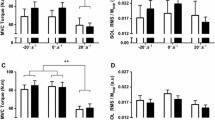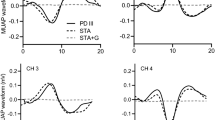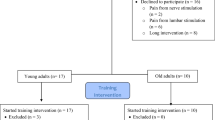Abstract
Although reductions in resting H-reflex responses and maximal firing frequency suggest that reduced efferent drive may limit muscle strength in elderly, there are currently no reports of V-wave measurements in elderly, reflecting the magnitude of efferent output to the muscle during maximal contraction. Furthermore, it is uncertain whether potential age-related neural deficiencies can be restored by resistance training. We assessed evoked reflex recordings in the triceps surae muscles during rest and maximal voluntary contraction (MVC), rate of force development (RFD), and muscle mass in seven elderly (74 ± 6 years) males before and after 8 weeks of heavy resistance training, contrasted by seven young (24 ± 4 years) male controls. At baseline, m. soleus (SOL) V/M ratio (0.124 ± 0.082 vs. 0.465 ± 0.197, p < 0.05) and H/M ratio (0.379 ± 0.044 vs. 0.486 ± 0.101 p = 0.07) were attenuated in elderly compared to young. Also, SOL H-reflex latency (33.29 ± 2.41 vs. 30.29 ± 0.67 ms, p < 0.05) was longer in elderly. The reduced neural drive was, despite similar leg muscle mass (10.7 ± 1.2 vs. 11.5 ± 1.4 kg), mirrored by lower MVC (158 ± 48 vs. 240 ± 54 Nm, p < 0.05) and RFD (294 ± 126 vs. 533 ± 123 Nm s−1, p < 0.05) in elderly. In response to training SOL V/M ratio (0.184 ± 0.092, p < 0.05) increased in the elderly, yet only to a level ∼40 % of the young. This was accompanied by increased MVC (190 ± 70 Nm, p < 0.05) and RFD (401 ± 147 Nm⋅s−1, p < 0.05) to levels of ∼80 % and ∼75 % of the young. H/M ratio remained unchanged. These findings suggest that changes in supraspinal activation play a significant role in the age-related changes in muscle strength. Furthermore, this motor system impairment can to some extent be improved by heavy resistance training.



Similar content being viewed by others
Abbreviations
- 1RM:
-
One repetition maximum
- GL:
-
Musculus gastrocnemius lateralis
- GM:
-
Musculus gastrocnemius medialis
- Hmax :
-
Maximal H-reflex amplitude
- Mmax :
-
Maximal M-wave amplitude obtained during rest
- Msup :
-
Maximal M-wave amplitude obtained during maximal voluntary contraction
- MVC:
-
Maximal voluntary contraction
- RFD:
-
Rate of force development
- TA:
-
Musculus tibialis anterior
- Vmax :
-
Maximal V-wave amplitude
References
Aagaard P (2003) Training-induced changes in neural function. Exerc Sport Sci Rev 31:61–67
Aagaard P, Simonsen EB, Andersen JL, Magnusson P, Dyhre-Poulsen P (2002) Neural adaptation to resistance training: changes in evoked V-wave and H-reflex responses. J Appl Physiol (1985) 92:2309–2318
Aagaard P, Suetta C, Caserotti P, Magnusson SP, Kjaer M (2010) Role of the nervous system in sarcopenia and muscle atrophy with aging: strength training as a countermeasure. Scand J Med Sci Spor 20:49–64
(2009). American College of Sports Medicine position stand. Progression models in resistance training for healthy adults. Med Sci Sports Exerc 41, 687–708
Behm DG, Sale DG (1993) Intended rather than actual movement velocity determines velocity-specific training response. J Appl Physiol (1985) 74:359–368
Campbell AJ, Borrie MJ, Spears GF (1989) Risk factors for falls in a community-based prospective study of people 70 years and older. J Gerontol 44:M112–M117
Caserotti P, Aagaard P, Buttrup Larsen J, Puggaard L (2008) Explosive heavy-resistance training in old and very old adults: changes in rapid muscle force, strength and power. Scand J Med Sci Spor 18:773–782
Ciolac EG, Brech GC, Greve JM (2010a) Age does not affect exercise intensity progression among women. J Strength Cond Res 24:3023–3031
Ciolac EG, Garcez-Leme LE, Greve JM (2010b) Resistance exercise intensity progression in older men. Int J Sports Med 31:433–438
de Vos NJ, Singh NA, Ross DA, Stavrinos TM, Orr R, Fiatarone Singh MA (2005) Optimal load for increasing muscle power during explosive resistance training in older adults. J Gerontol A Biol Sci Med Sci 60:638–647
Del Balso C, Cafarelli E (2007) Adaptations in the activation of human skeletal muscle induced by short-term isometric resistance training. J Appl Physiol (1985) 103:402–411
deVries HA, Wiswell RA, Romero GT, Heckathorne E (1985) Changes with age in monosynaptic reflexes elicited by mechanical and electrical stimulation. Am J Phys Med 64:71–81
Duclay J, Martin A (2005) Evoked H-reflex and V-wave responses during maximal isometric, concentric, and eccentric muscle contraction. J Neurophysiol 94:3555–3562
Ekblom MM (2010) Improvements in dynamic plantar flexor strength after resistance training are associated with increased voluntary activation and V-to-M ratio. J Appl Physiol (1985) 109:19–26
Ferri A, Scaglioni G, Pousson M, Capodaglio P, Van Hoecke J, Narici MV (2003) Strength and power changes of the human plantar flexors and knee extensors in response to resistance training in old age. Acta Physiol Scand 177:69–78
Fimland MS, Helgerud J, Gruber M, Leivseth G, Hoff J (2009) Functional maximal strength training induces neural transfer to single-joint tasks. Eur J Appl Physiol 107:21–29
Fimland MS, Helgerud J, Gruber M, Leivseth G, Hoff J (2010) Enhanced neural drive after maximal strength training in multiple sclerosis patients. Eur J Appl Physiol 110:435–443
Fimland MS, Moen PM, Hill T, Gjellesvik TI, Torhaug T, Helgerud J, Hoff J (2011) Neuromuscular performance of paretic versus non-paretic plantar flexors after stroke. Eur J Appl Physiol 111:3041–3049
Fleming BE, Wilson DR, Pendergast DR (1991) A portable, easily performed muscle power test and its association with falls by elderly persons. Arch Phys Med Rehab 72:886–889
Folland JP, Williams AG (2007) The adaptations to strength training : morphological and neurological contributions to increased strength. Sports Med 37:145–168
Geirsdottir OG, Arnarson A, Briem K, Ramel A, Tomasson K, Jonsson PV, Thorsdottir I (2012) Physical function predicts improvement in quality of life in elderly Icelanders after 12 weeks of resistance exercise. J Nutr Health Aging 16:62–66
Harridge SD, Kryger A, Stensgaard A (1999) Knee extensor strength, activation, and size in very elderly people following strength training. Muscle Nerve 22:831–839
Heggelund J, Morken G, Helgerud J, Nilsberg GE, Hoff J (2012) Therapeutic effects of maximal strength training on walking efficiency in patients with schizophrenia - a pilot study. BMC Res Notes 5:344
Herbert RD, Gandevia SC (1999) Twitch interpolation in human muscles: mechanisms and implications for measurement of voluntary activation. J Neurophysiol 82:2271–2283
Hermens HJ, Freriks B, Disselhorst-Klug C, Rau G (2000) Development of recommendations for SEMG sensors and sensor placement procedures. J Electromyogr Kinesiol 10:361–374
Hill TR, Gjellesvik TI, Moen PM, Torhaug T, Fimland MS, Helgerud J, Hoff J (2012) Maximal strength training enhances strength and functional performance in chronic stroke survivors. Am J Phys Med Rehabil 91:393–400
Hoff J, Tjonna AE, Steinshamn S, Hoydal M, Richardson RS, Helgerud J (2007) Maximal strength training of the legs in COPD: a therapy for mechanical inefficiency. Med Sci Sports Exerc 39:220–226
Hughes VA, Frontera WR, Dallal GE, Lutz KJ, Fisher EC, Evans WJ (1995) Muscle strength and body composition: associations with bone density in older subjects. Med Sci Sports Exerc 27:967–974
Husby VS, Helgerud J, Bjorgen S, Husby OS, Benum P, Hoff J (2009) Early maximal strength training is an efficient treatment for patients operated with total hip arthroplasty. Arch Phys Med Rehabil 90:1658–1667
Hvid L, Aagaard P, Justesen L, Bayer ML, Andersen JL, Ortenblad N, Kjaer M, Suetta C (2010) Effects of aging on muscle mechanical function and muscle fiber morphology during short-term immobilization and subsequent retraining. J Appl Physiol (1985) 109:1628–1634
Hyatt RH, Whitelaw MN, Bhat A, Scott S, Maxwell JD (1990) Association of muscle strength with functional status of elderly people. Age Ageing 19:330–336
Izquierdo M, Aguado X, Gonzalez R, Lopez JL, Hakkinen K (1999) Maximal and explosive force production capacity and balance performance in men of different ages. Eur J Appl Physiol O 79:260–267
Jubrias SA, Odderson IR, Esselman PC, Conley KE (1997) Decline in isokinetic force with age: muscle cross-sectional area and specific force. Pflugers Arch 434:246–253
Kamen G, Knight CA (2004) Training-related adaptations in motor unit discharge rate in young and older adults. J Gerontol A Biol Sci Med Sci 59:1334–1338
Kamen G, Sison SV, Du CC, Patten C (1995) Motor unit discharge behavior in older adults during maximal-effort contractions. J Appl Physiol (1985) 79:1908–1913
Kennis E, Verschueren S, Van Roie E, Thomis M, Lefevre J, Delecluse C (2014) Longitudinal impact of aging on muscle quality in middle-aged men. Age (Dordr) 36:9689
Kido A, Tanaka N, Stein RB (2004) Spinal excitation and inhibition decrease as humans age. Can J Physiol Pharmacol 82:238–248
Klass M, Baudry S, Duchateau J (2008) Age-related decline in rate of torque development is accompanied by lower maximal motor unit discharge frequency during fast contractions. J Appl Physiol (1985) 104:739–746
Klitgaard H, Mantoni M, Schiaffino S, Ausoni S, Gorza L, Laurent-Winter C, Schnohr P, Saltin B (1990) Function, morphology and protein expression of ageing skeletal muscle: a cross-sectional study of elderly men with different training backgrounds. Acta Physiol Scand 140:41–54
Koceja DM, Markus CA, Trimble MH (1995) Postural modulation of the soleus H reflex in young and old subjects. Electroencephalogr Clin Neurophysiol 97:387–393
Kosek DJ, Kim JS, Petrella JK, Cross JM, Bamman MM (2006) Efficacy of 3 days/wk resistance training on myofiber hypertrophy and myogenic mechanisms in young vs. older adults. J Appl Physiol (1985) 101:531–544
Larsson L, Grimby G, Karlsson J (1979) Muscle strength and speed of movement in relation to age and muscle morphology. J Appl Physiol Respir Environ Exerc Physiol 46:451–456
Lindle RS, Metter EJ, Lynch NA, Fleg JL, Fozard JL, Tobin J, Roy TA, Hurley BF (1997) Age and gender comparisons of muscle strength in 654 women and men aged 20-93 year. J Appl Physiol (1985) 83:1581–1587
Macaluso A, De Vito G (2004) Muscle strength, power and adaptations to resistance training in older people. Eur J Appl Physiol 91:450–472
Mau-Moeller A, Behrens M, Lindner T, Bader R, Bruhn S (2013) Age-related changes in neuromuscular function of the quadriceps muscle in physically active adults. J Electromyogr Kinesiol 23:640–648
McGinley M, Hoffman RL, Russ DW, Thomas JS, Clark BC (2010) Older adults exhibit more intracortical inhibition and less intracortical facilitation than young adults. Exp Gerontol 45:671–678
McNeil CJ, Doherty TJ, Stashuk DW, Rice CL (2005) Motor unit number estimates in the tibialis anterior muscle of young, old, and very old men. Muscle Nerve 31:461–467
McNeil CJ, Butler JE, Taylor JL, Gandevia SC (2013) Testing the excitability of human motoneurons. Front Hum Neurosci 7:152
Metter EJ, Conwit R, Metter B, Pacheco T, Tobin J (1998) The relationship of peripheral motor nerve conduction velocity to age-associated loss of grip strength. Aging (Milano) 10:471–478
Misiaszek JE (2003) The H-reflex as a tool in neurophysiology: its limitations and uses in understanding nervous system function. Muscle Nerve 28:144–160
Moritani T, deVries HA (1979) Neural factors versus hypertrophy in the time course of muscle strength gain. Am J Phys Med 58:115–130
Morse CI, Thom JM, Davis MG, Fox KR, Birch KM, Narici MV (2004) Reduced plantarflexor specific torque in the elderly is associated with a lower activation capacity. Eur J Appl Physiol 92:219–226
Mosti MP, Kaehler N, Stunes AK, Hoff J, Syversen U (2013) Maximal strength training in postmenopausal women with osteoporosis or osteopenia. J Strength Cond Res 27:2879–2886
Narici MV, Maffulli N (2010) Sarcopenia: characteristics, mechanisms and functional significance. Br Med Bull 95:139–159
Roos MR, Rice CL, Vandervoort AA (1997) Age-related changes in motor unit function. Muscle Nerve 20:679–690
Sabbahi MA, Sedgwick EM (1982) Age-related changes in monosynaptic reflex excitability. J Gerontol 37:24–32
Sale DG, Macdougall JD, Upton ARM, Mccomas AJ (1983) Effect of strength training upon motoneuron excitability in Man. Med Sci Sport Exer 15:57–62
Scaglioni G, Ferri A, Minetti AE, Martin A, Van Hoecke J, Capodaglio P, Sartorio A, Narici MV (2002) Plantar flexor activation capacity and H reflex in older adults: adaptations to strength training. J Appl Physiol (1985) 92:2292–2302
Scaglioni G, Narici MV, Maffiuletti NA, Pensini M, Martin A (2003) Effect of ageing on the electrical and mechanical properties of human soleus motor units activated by the H reflex and M wave. J Physiol 548:649–661
Sillanpaa E, Stenroth L, Bijlsma AY, Rantanen T, McPhee JS, Maden-Wilkinson TM, Jones DA, Narici MV, Gapeyeva H, Paasuke M, Barnouin Y, Hogrel JY, Butler-Browne GS, Meskers CG, Maier AB, Tormakangas T, Sipila S (2014) Associations between muscle strength, spirometric pulmonary function and mobility in healthy older adults. Age (Dordr) 36:9667
Solstad GM, Fimland MS, Helgerud J, Iversen VM, Hoff J (2011) Test-retest reliability of v-wave responses in the soleus and gastrocnemius medialis. J Clin Neurophysiol 28:217–221
Storen O, Helgerud J, Stoa EM, Hoff J (2008) Maximal strength training improves running economy in distance runners. Med Sci Sports Exerc 40:1087–1092
Suetta C, Aagaard P, Magnusson SP, Andersen LL, Sipila S, Rosted A, Jakobsen AK, Duus B, Kjaer M (2007) Muscle size, neuromuscular activation, and rapid force characteristics in elderly men and women: effects of unilateral long-term disuse due to hip-osteoarthritis. J Appl Physiol 102:942–948
Tracy BL, Ivey FM, Hurlbut D, Martel GF, Lemmer JT, Siegel EL, Metter EJ, Fozard JL, Fleg JL, Hurley BF (1999) Muscle quality. II. Effects of strength training in 65- to 75-yr-old men and women. J Appl Physiol (1985) 86:195–201
Upton AR, McComas AJ, Sica RE (1971) Potentiation of “late” responses evoked in muscles during effort. J Neurol Neurosurg Psychiatry 34:699–711
Vandervoort AA, Hayes KC (1989) Plantarflexor muscle function in young and elderly women. Eur J Appl Physiol Occup Physiol 58:389–394
Verdijk LB, Gleeson BG, Jonkers RAM, Meijer K, Savelberg HHCM, Dendale P, van Loon LJC (2009) Skeletal muscle hypertrophy following resistance training is accompanied by a fiber type-specific increase in satellite cell content in elderly men. J Gerontol A-Biol 64:332–339
Vila-Cha C, Falla D, Correia MV, Farina D (2012) Changes in H reflex and V wave following short-term endurance and strength training. J Appl Physiol (1985) 112:54–63
Wang E, Naess MS, Hoff J, Albert TL, Pham Q, Richardson RS, Helgerud J (2014) Exercise-training-induced changes in metabolic capacity with age: the role of central cardiovascular plasticity. Age (Dordr) 36:665–676
Winegard KJ, Hicks AL, Sale DG, Vandervoort AA (1996) A 12-year follow-up study of ankle muscle function in older adults. J Gerontol A Biol Sci Med Sci 51:B202–B207
Young A, Stokes M, Crowe M (1985) The size and strength of the quadriceps muscles of old and young men. Clin Physiol 5:145–154
Zehr EP (2002) Considerations for use of the Hoffmann reflex in exercise studies. Eur J Appl Physiol 86:455–468
Zehr EP (2006) Training-induced adaptive plasticity in human somatosensory reflex pathways. J Appl Physiol (1985) 101:1783–1794
Acknowledgments
The authors would like to thank the senior citizens who volunteered to participate in this study for their time and efforts.
Conflict of interests
The authors declare that they have no conflict of interest regarding the publication of this paper. The study was funded by the Norwegian University of Science and Technology.
Author information
Authors and Affiliations
Corresponding author
About this article
Cite this article
Unhjem, R., Lundestad, R., Fimland, M.S. et al. Strength training-induced responses in older adults: attenuation of descending neural drive with age. AGE 37, 47 (2015). https://doi.org/10.1007/s11357-015-9784-y
Received:
Accepted:
Published:
DOI: https://doi.org/10.1007/s11357-015-9784-y




